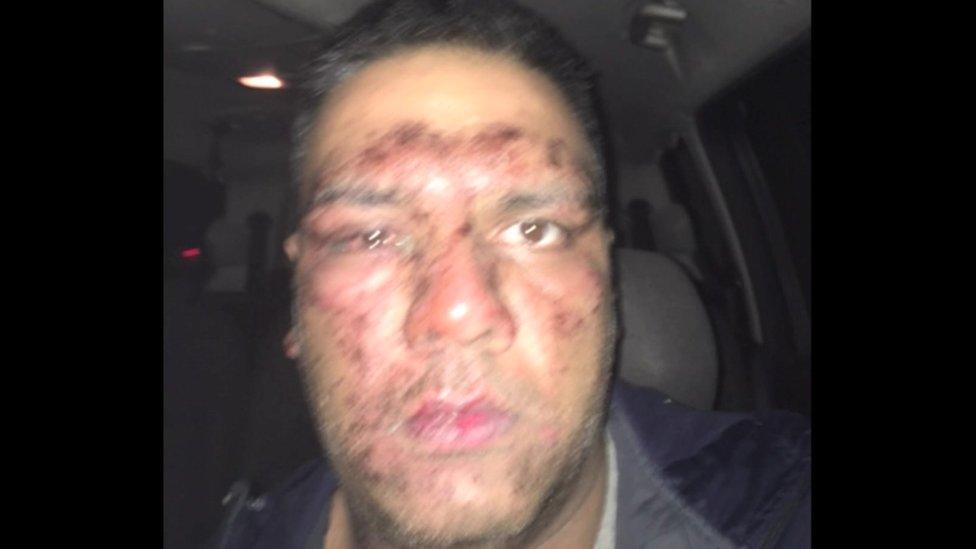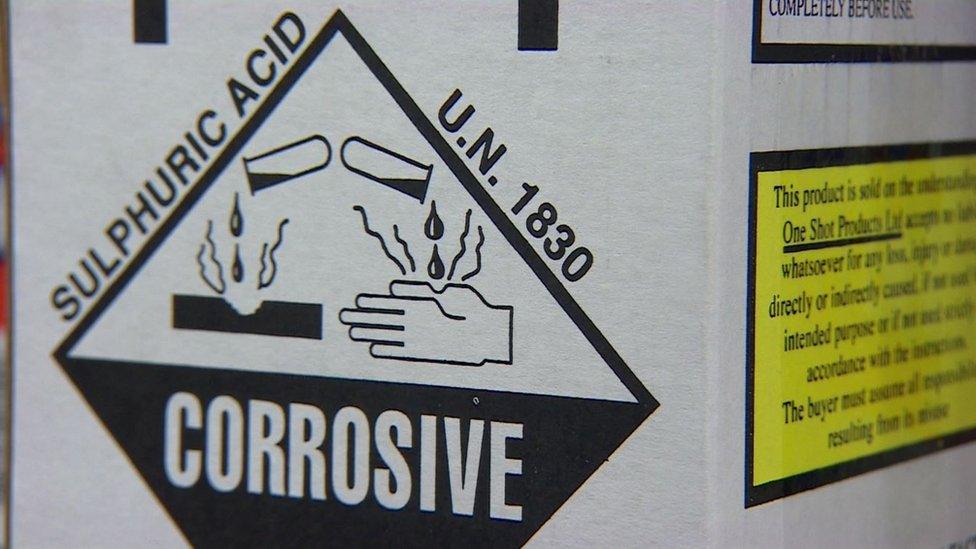Acid attacks: What has led to the rise and how can they be stopped?
- Published

Resham Khan was left with burns on her face, arms, legs and shoulder after having acid thrown at her
The latest acid attacks in north-east London on Thursday, which saw five people being sprayed with a corrosive liquid, add to a growing number of cases being reported in the UK.
Last month cousins Resham Khan and Jameel Muhktar were left with life-changing injuries after a corrosive liquid was thrown at them through a car window.
And in April clubbers in east London were caught up in an attack involving acid, which left 20 people injured.
Assaults involving corrosive substances have more than doubled in England since 2012, police figures show.
The vast majority of cases were in London.
It is legal to purchase strong acid but there have been growing calls for regulations to be tightened in the wake of recent incidents.
The National Police Chiefs Council lead for corrosive attacks, Assistant Chief Constable Rachel Kearton, told the BBC Asian Network that reported acid attacks had seen a significant rise in percentage terms, but that compared with knife crime the number of incidents were "tiny".

'I thought I was going blind'

Imran Khan suffered facial injuries after being attacked while delivering food in east London
Takeaway restaurant owner Imran Khan was attacked while out delivering food in Barking, east London, in November.
He was confronted by a group of youths who demanded money and food while hurling racist abuse at him. When he got back into his vehicle they squirted a corrosive liquid in his face.
Mr Khan says the pain "overtook everything" and he feared he would be left completely blind.
He was saved from long-term damage by a quick thinking shopkeeper who washed his face with clean water at the scene of the attack.
He says the attack affected him "big time" leaving him feeling unsafe in public, especially after dark.

Weapon of choice
Metropolitan Police figures obtained by the BBC show men are twice as likely to be victims of acid attacks in London than women after being linked to a number of gang crimes.
The vast majority of cases never reach trial.
Dr Simon Harding, a criminologist and expert on gangs at Middlesex University, says acid is becoming "a weapon of first choice".
"Acid throwing is a way of showing dominance, power and control, building enormous fear among gang peer groups," he says.
Gang members know there are advantages in using acid to hurt someone rather than a knife because "the charges are more serious if you are caught with a knife and the tariff for prison sentences are much higher".
Dr Harding added that "acid is likely to attract a 'GBH with intent' charge while using a knife is more likely to lead to the attacker being charged with attempted murder"
"There's no specific offence of throwing acid. It's a harder offence to prove because there is rarely any DNA evidence and its much easier to dispose of a plastic bottle than it is a knife."
Dr Harding says the government needs to attack the problem on three fronts.
He says acid is too easily available, sentencing needs to be brought into line with knife crime and a programme of education is required.
"Gang members do respond when they realise a victim of an acid attack may never work again or may need 15 or 20 plastic surgery operations."
Physical and emotional damage

Isobella Fraser was caught up in the acid attack at a London nightclub in April and was treated for injuries to her back and arms
"This is a horrendous crime, it maims, it disfigures," ACC Kearton explains.
"What particularly disgusts me about this crime is that it's premeditated, no-one carries acid around on the streets for any other reason than using it for this reason.
"The intention behind this is for someone to live with this for the rest of their lives.
"That is lasting physical and emotional damage, its sometimes why some people choose this as a form of attack."
Asked what can be done to stop it she says: "To have an acid in a different bottle to the one it was purchased in can be an offence, we can also regulate volumes of sale, we can regulate ages at which people can buy it."
Jaf Shah, from the London charity Acid Survivors Trust International, external says the phenomenon isn't new and dates back to the Victorian times in Britain, but says the recent figures are shocking.
"The recent spike in attacks means the UK has the highest number of reported acid attacks per capita in the world."
He is among those calling for regulations on the sale of acid to be tightened.
What should you do in case of a chemical burn?
What does the law say?
There are no age restrictions on buying household bleach or drain cleaning products containing acid in the UK.
There are rules which limit the sale of certain substances under the explosives precursors and poisons (EPP) rules, external aimed at businesses who sell or supply such chemicals in bulk.
The Met said it was working with retailers to raise awareness that people might be buying corrosive substances to use as weapons.
But Jaf Shah wants the government to make it compulsory when purchasing corrosive chemicals to pay by card that is traceable to an individual and to make acid available only under licence.
Labour MP for East Ham Stephen Timms has tabled an adjournment debate for Monday in the House of Commons, external on the rise in the number of acid attacks.
About a third of last year's acid attacks in the capital took place in the London borough of Newham, which is in his constituency.
Mr Timms says he is "most concerned about sulphuric acid" and that carrying a bottle without justification should be treated as an offence, like carrying a knife.
- Published14 July 2017

- Published26 June 2017

- Published22 April 2017

- Published20 March 2017
